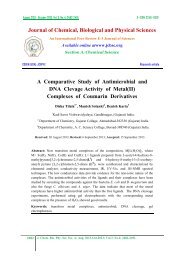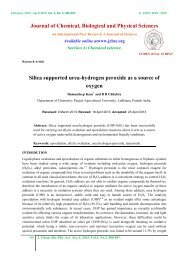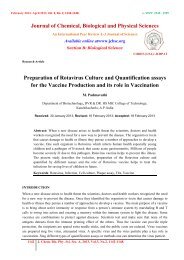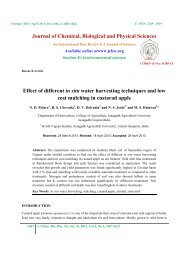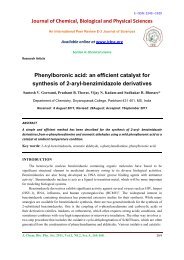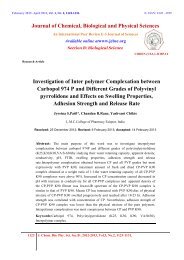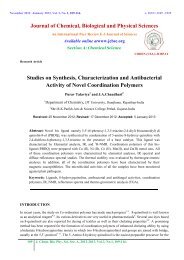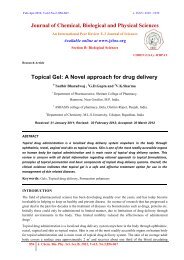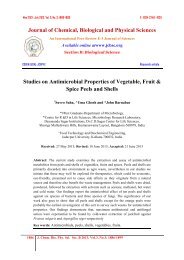A Validated reverse phase HPLC method for simultaneous ...
A Validated reverse phase HPLC method for simultaneous ...
A Validated reverse phase HPLC method for simultaneous ...
You also want an ePaper? Increase the reach of your titles
YUMPU automatically turns print PDFs into web optimized ePapers that Google loves.
A <strong>Validated</strong> High....Padmanabh B. Deshpande et alPrecision: The precision of the <strong>method</strong> was demonstrated by inter day and intra day variation studies.To study intra-day variation, six mixed standard solutions containing TELMI (10 µg/mL), RAMI (10µg/mL) and PPA (10 µg/mL) were injected. All the solutions were analyzed on the same day to recordany intra-day variation in the results. To study inter-day variation, analysis of three mixed standardsolutions of the same concentration was per<strong>for</strong>med on different days.Accuracy: To study accuracy of the proposed <strong>method</strong>, recovery studies were carried out by additionof standard drug solution to pre-analyzed sample at three different levels 50 %, 100 % and 150 %. Thepercentages of recoveries were calculated, results of which are represented in Table 2.Level of% RecoveryTable 2: Recovery studies of TELMI and RAMI% Mean Recovery ∗ Standard Deviation % R.S.D.TELMI RAMI TELMI RAMI TELMI RAMI50 99.96 100.17 0.571 0.706 0.571 0.705100 100.27 100.40 0.494 0.484 0.492 0.482150 100.11 99.87 0.563 0.462 0.563 0.462LOD and LOQLOD and LOQ were calculated as 3.3 σ /S and 10 σ /S, respectively, where σ is the standarddeviation of the response (y-intercept) and S is the slope of the calibration plot.Robustness: To determine the robustness of the developed <strong>method</strong>, slight deliberate changes inchromatographic conditions was carried out. The factors varied one at a time were change in flow rate(± 0.02 mL/min), detection wavelength (±1 nm) and ratio of the mobile <strong>phase</strong> constituents (± 2 %). Itwas observed that there were no marked changes in the chromatograms, which demonstrated that theRP-<strong>HPLC</strong> <strong>method</strong> developed is robust.Solution Stability: In order to demonstrate the stability of both standard and sample solutions, thesolutions were analyzed over a period of 5 hours at room temperature. The results show that retentiontime as well as peak area of TELMI and RAMI remained almost unchanged (% RSD less than 1.5) andno significant degradation within the indicated period was observed, this indicates that both solutionswere stable <strong>for</strong> at least 5 hours, which was sufficient to complete the whole analytical process.RESULTS AND DISCUSSIONResults were found to be linear in the concentration range of 10-50 µg/mL <strong>for</strong> TELMI and 2.5-12.5 µg/mL <strong>for</strong> RAMI with high correlation coefficient. The detection wavelength 216 nm was selectedas RAMI have negligible absorbance at higher wavelengths. The proposed <strong>method</strong> was also evaluatedby the assay of commercially available tablets containing TELMI and RAMI. The % assay was foundto be 99.77 ± 0.084 <strong>for</strong> TELMI and 99.00 ± 0.688 <strong>for</strong> RAMI (mean ± S.D., n = 6). The <strong>method</strong> wasfound to be accurate and precise, as indicated by recovery studies and % RSD not more than 1.5. Thesummary of validation parameters of proposed <strong>HPLC</strong> <strong>method</strong> is given in Table 3.J. Chem. Bio. Phy. Sci. 2011, Vol.1, N0.2, Sec.B, 283-288. 286



